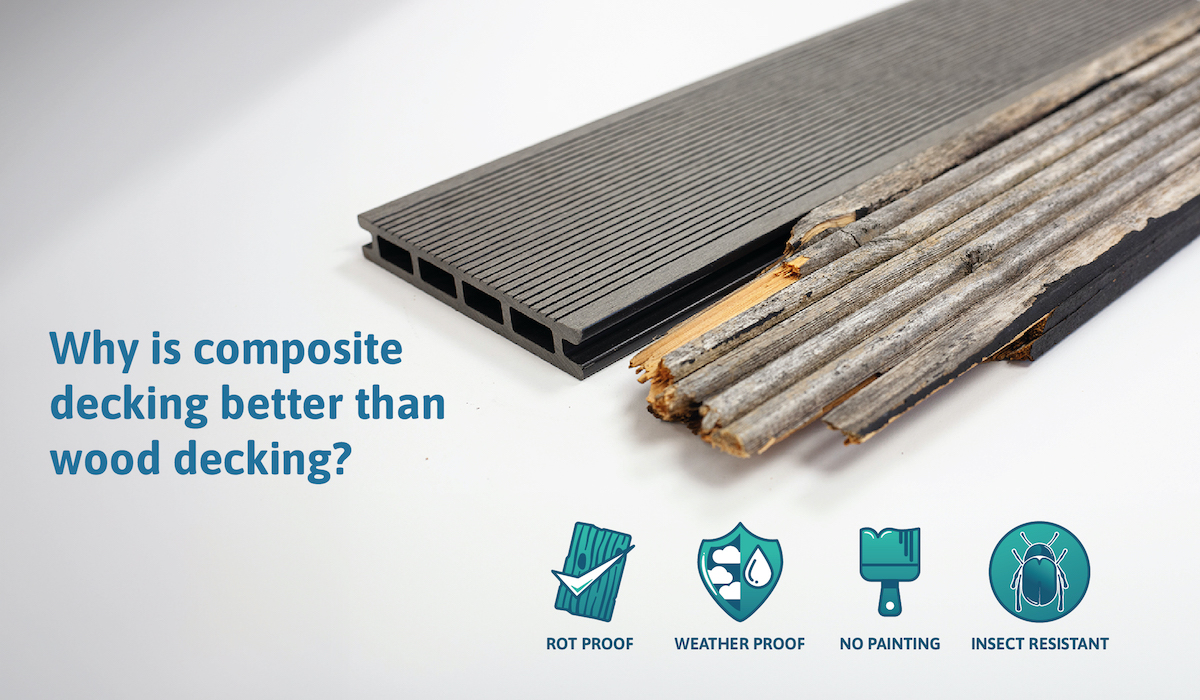
What are the main differences between real wood timber decking and composite decking?
What is composite decking?
Composite decking, or wood polymer composite (WPC) decking is constructed using a mixture of wood fibres, plastics and a small amount of bonding agents to bring the materials together.
During the creation and manufacture of our products, we ensure that the materials going into our composite boards are environmentally sustainable. The plastics used in the process are fully recycled and the wood content is both recycled and PEFC certified.
The creation of the board lengths come from when the wood fibres, plastics and bonding agents are mixed together and then heated up and shaped. This mix of materials allows for the creation of wood composite decking that requires less maintenance than traditional timber boards and looks more life-like than plastic alternatives - the best of both worlds!
Capped vs uncapped
The difference between capped and uncapped composite boards tends to come in price and protection. Capped composite boards come with a coating on the exterior that makes the boards extra resistant against both staining and fading. These boards are also easy to wipe clean and maintain their colour when exposed to the outdoor elements.
Uncapped composite boards tend to be a little cheaper, but the difference with these boards is that they do not come with the same protection against colour fading and staining. This means that uncapped composite boards may fade a small amount in the first few months of use.
Hollow vs solid
Composite decking boards come in both hollow and solid varieties. Hollow boards have chambers that run the length of the board, whilst solid boards are one complete chunk. The advantages of having a hollow board are that they offer great strength whilst also being more accessible in price. Hollow boards also do not warp like solid boards can and are also not as heavy.
Is wood decking cheaper than composite decking?
Whilst wood decking is regularly seen as the cheaper and more common route to creating a decking space in your garden, over time, a quality composite deck is an investment that is guaranteed to pay dividends.
The initial outlay for a WPC deck will more than likely be expensive in comparison to the conventional timber decking alternative, but the qualities of the composite deck will save you both time and energy in the long run. Wood-plastic composites are renowned for their longevity compared to traditional wood decking that usually needs replacing after as little as five to ten years if meticulous maintenance programmes are not kept up.
Dream Decking composite decking ranges are low maintenance and are built to last - highly durable and complete with anti-slip, anti-rot and anti-splinter technologies to guard against whatever the years have to throw. These boards come complete with great residential warranties to keep you protected against extra costs and worries that you’d usually encounter with the standard wood decking maintenance woes.
How much would I save on maintenance costs?
The level of maintenance needed to keep a traditional wooden deck looking great varies depending on the type of wood it is made of. Treatments can vary from an annual re-oiling, re-finishing or re-painting; The long term costs of which can be huge when taking into account that the materials involved can cost over £150 per treatment. This makes the lifetime cost for composite decking undeniably lower.
Composite decking is a low maintenance option and unlike its wooden counterpart, rarely needs more than a hosing down once or twice a year. This gives you more time to enjoy your decking, rather than having to worry about spending money on re-painting, re-treating or re-finishing in order to have a good looking, durable decking solution.
Is composite decking better for the environment?
The final question to ask in the composite decking versus traditional wooden decking is about the environmental impact of both products. Wooden decking on the surface seems like a sustainable approach, but the hidden cost of the environmental damage that traditional decks cause to our planet is hidden beneath.
Although some companies are certified by sustainable means, both softwood and hardwood materials lead to deforestation and the loss of vital habitats to wildlife across the globe, leaving many animals struggling to survive…all in the name of wood decking.
This is something that we considered during the specification of our composite decking - by aiming to use recycled materials as much as we can and ensuring that our process for manufacture is sustainable.


